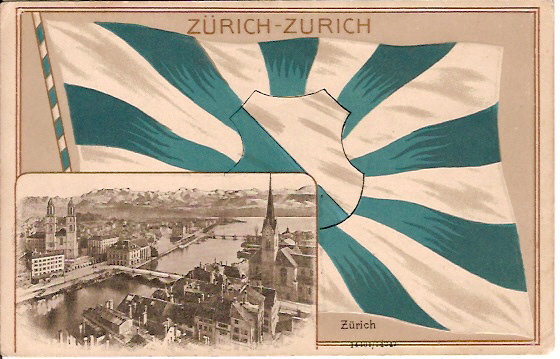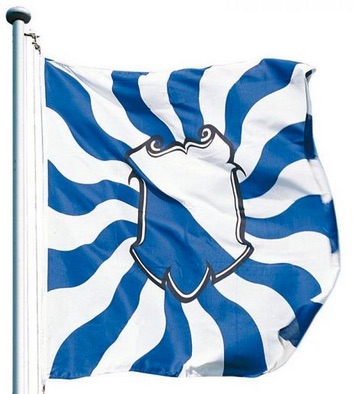
This page is part of © FOTW Flags Of The World website
Zürich canton (Switzerland)
Last modified: 2024-10-05 by martin karner
Keywords: switzerland | zürich | zurich | german |
Links: FOTW homepage |
search |
disclaimer and copyright |
write us |
mirrors
![[Flag of Zürich]](../images/c/ch-zh.gif) image
by António Martins, 22 February 2024
image
by António Martins, 22 February 2024
See also:
Description of the flag
Per bend azure and argent.
Diagonally divided from the upper hoist to the lower fly into equal
blue and white parts, with the blue all in the edge of the hoist.
T.F. Mills, 17 October 1997
Symbolism of the flag
Like Luzern, blue was said to denote the lake, and white the snow
capped mountains around it. Somewhat ironically, white used to
signify water, while blue represented the sky. The diagonal division
("per bend") is supposed to represent justice.
T.F. Mills, 17 October 1997
History of the flag
Zurich attained the rank of "Reichs-immediacy" in 1218, which makes
it along with Schaffhausen the oldest sovereign state in the Holy
Roman Empire which later became part of Switzerland. Its flag is
also one of the oldest, its first documented use being 1220. The
seal of the Zurich Council, with the same design, dates from 1225.
Independence implied troops to defend it, and troops were never
without their war banner. Zurich joined the Swiss Confederation in
1351, and soon dominated it militarily with its flag flying on the
highest flagstaff. Zurich was one of the recipients of the Pope
Julius banners in 1512, but they discarded it during the Protestant
reformation and started carrying in to battle a hundred-year old
flag which had been retired after the Burgundian wars.
In 1273 Zurich's banner was adorned with a red "Schwenkel" ("chef" in
French for lack of a better word), which is a very long pennon (see image).
Conflicting reports put it at 1278 or 1348. This was regarded as a
high honour and/or a mark of sovereignty, but there are conflicting
reports from the Middle Ages that it was also a mark of shame (e.g. a
sign that the previous banner had been lost in battle). After the
battle of Nancy in 1477, the Duke of Lorraine removed the Schwenkels
from Swiss banners saying they had erased their shame, but when the
troops got home they restored the Schwenkels since they considered
them marks of honour and not shame. A little white cross on the
Schwenkel probably came with the original pennon. The Schwenkel
very strongly resembles the flag of Schwyz or modern Switzerland,
and other confederate states adopted it in the 15th century, but
there is no documentation explaining its meaning for other states
and no proof that it was a mark of the Confederacy.
T.F. Mills, 17 October 1997
[Main banner of Zürich (1437, reverse), carried in the Old Zürich War (1440–46;) (source: [b7b42]). –
Shooter flag, carried during the Dijon campaign, 1513 (source: [m2m93]). Reverse side (source: [b7b42]) (cf. Shooting Club Flag). –
Stained glass plate (detail), 1557, dedicated from the city of Zürich to the monastery of Muri (today's location). Zürich flag with Schwenkel. The two
lions are the heraldic animals of Zürich (source). –
Stained glass plate from Lukas Zeiner, ca. 1490, with two Zürich flags, one showing the three Christian martyrs and patron
saints of Zürich, Felix, Regula and Exuperantius (Those martyrs are also on the Zürich city and state seals, source) (source). –
Banner bearer, Zürich banner with Schwenkel, part of
a painting series from Humbert Mareschet with paintings of the banner bearers of all 13 cantons of that
time (1585, picture) (source). –
Cavalry standard (2nd half 18th c.). Inscription: "S.PQ.T." (Senatus PopulusQue Turicensis, The Senate and
the People of Zürich) (source: [m2m93])]
Cantonal banner of Zürich with its red Schwenkel
![[Cantonal banner of Zürich with red Schwenkel]](../images/c/ch-zh15.gif) image
by T.F. Mills
image
by T.F. Mills
The Schwenkel, granted in 1273, may have influenced the development
of the Swiss flag, but did not in of itself signify Zurich's
membership in the Swiss Confederation.
T.F. Mills, 14 November 1997
See also: • SCHWENKEL in Dictionary of Vexillology
•
Der Schwenkel (by Günter Mattern, ICV 15, 1993, German)
Colour Flag
![[Colour Flag ZH]](../images/c/ch-zh_56.gif) image
by Ole Andersen
image
by Ole Andersen
Rectangular cantonal flag, as shown in Kannik (1956)
[So-called Farbenfahne (colour flag); in the case of ZH divided diagonally instead of horizontally].
Ole Andersen, 4 August 2002
See also: STATE COLOURS in Dictionary of Vexillology
Flaggen, Knatterfahnen and Livery Colours
|
![[Knatterfahnen]](../images/c/ch-zh_f.gif)
|
![[Knatterfahnen]](../images/c/ch-zh_kf.gif)
|
![[livery colours]](../images/c/ch-zh_ff.gif)
|
images
by Pascal Gross
Flaggen are vertically hoisted from a crossbar in the manner of gonfanon, in ratio of about 2:9, with a swallowtail that indents about 2 units. The chief, or hoist (square part) usually incorporates the design from the coat of arms – not from the flag. The fly part is always divided lengthwise, usually in a bicolour, triband or tricolour pattern (except Schwyz which is monocolour, and Glarus which has four stripes of unequal width). The colours chosen for the fly end are usually the main colours of the coat of arms, but the choice is not always straight forward.
Knatterfahnen are similar to Flaggen, but hoisted from the long side and have no swallow tail. They normally show the national, cantonal or communal flag in their chiefs.
Željko Heimer, 16 July 2000
See also: HANGING FLAG,
VERTICALLY HOISTED FLAG,
LIVERY COLOURS in Dictionary of Vexillology

 images located by Martin Karner
images located by Martin Karner
(source)
(source)
At the beginning of the 20th century, flamed flags were still in use, with the white cross replaced by
a (baroque) shield in the centre of the flag. These decorative flags had been used until WWII and then
somewhat forgotten in preference of the current cantonal flags. [Today they are being
produced again, see right image]
Pascal Gross, 30 June 2002
See also: • National flag and other cantonal flags with "Early 20th century flag design"
• Modern flamed flags
• FLAMMES in Dictionary of Vexillology
logo.jpg) image located by Martin Karner (8 May 2024)
image located by Martin Karner (8 May 2024)
(source)
![[Cantonal banner of Zürich with red Schwenkel]](../images/c/ch-zh15.gif) image
by T.F. Mills
image
by T.F. Mills

![[Flag of Zürich]](../images/c/ch-zh.gif) image
by António Martins, 22 February 2024
image
by António Martins, 22 February 2024
![[Colour Flag ZH]](../images/c/ch-zh_56.gif)
![[Knatterfahnen]](../images/c/ch-zh_f.gif)
![[Knatterfahnen]](../images/c/ch-zh_kf.gif)
![[livery colours]](../images/c/ch-zh_ff.gif)

 images located by Martin Karner
images located by Martin Karnerlogo.jpg) image located by Martin Karner (8 May 2024)
image located by Martin Karner (8 May 2024)